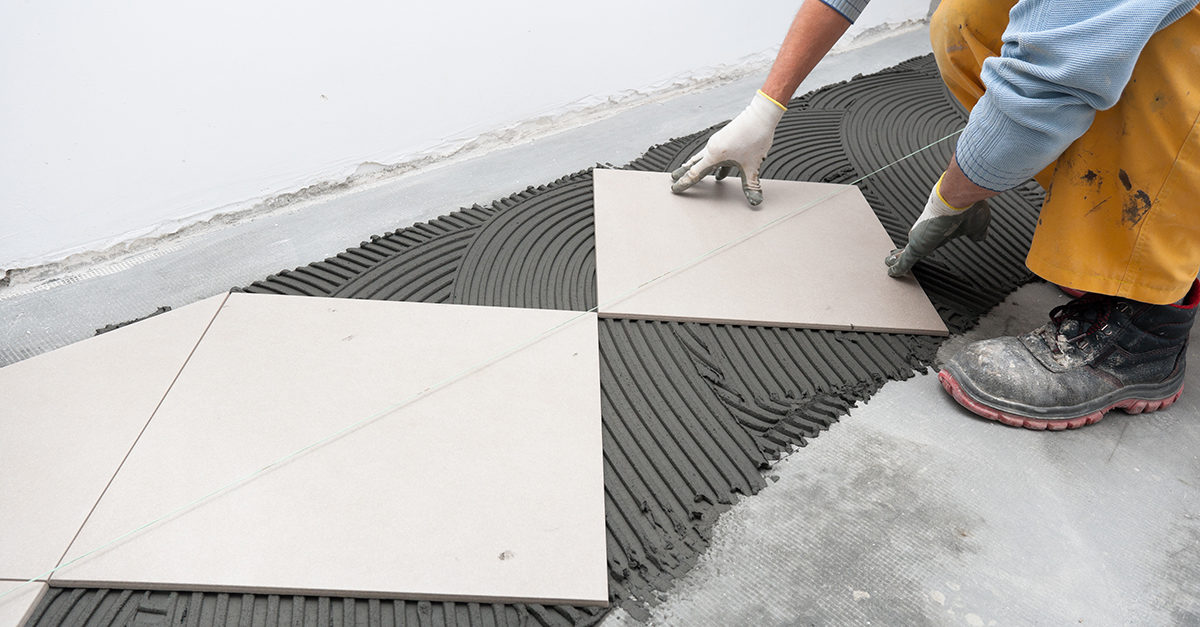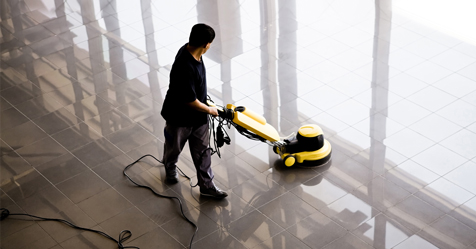As floor covering and related materials evolve, the design, build, maintenance, and related industries face a major conundrum. Slip, trip, fall, and hard surface floor-covering claims have now soared into billions of dollars. Is a floor-failure epidemic inevitable?
Root-Cause Analysis
Problems arise when standards (or lack thereof) conflict with specification and product performance. A paradox can occur when over-expectation and misspecification outweighs material performance capacity.
With recent advancements in technology, we have entered an exciting, yet challenging and sometimes frustrating, time. Because of new technologies and sustainability efforts, materials are becoming stronger, better made, more chemically resistant, biodegradable, and recyclable. But these positive changes come with unintended consequences and conditions that are created from complacency with the status quo, naiveté, and unfortunately, subject-matter ignorance.
The Costly Outcome
Despite ongoing efforts to educate, certify, and revise or develop standards, as advances in flooring materials continue to grow in popularity, the cost of claims rise. A colleague who saw his claim value climb into the tens of millions of dollars is just one example of how drastic these cost increases can be. Big numbers. Big challenges.
The last generation saw a surge in construction demand. While this surge had a positive effect on our economy, it had a downside that included the occassional use of substandard products; material shortages; sloppy or too broad specifications; devalued engineering to accommodate cheap, fast-track construction; sloppy workmanship, such as rushing concrete placement and covering the material too quickly with floorcovering; and ineffective job staging. Add to this the complicating factors that more severe weather conditions invite, and you have a prescription for product failure and moisture intrusion that can result in mold and indoor air quality problems. This can cause big problems down the line for facility managers and their staff.
For floors, the bottom line is this: A one-size-fits-all construction specification for below-grade, on-grade, and above-grade floor-covering installation does not work. On the flip side, implementing inspections and consulting support can help to prevent over-expectation of product, lower-quality workmanship, and misconception of product performance. Overall, it will help to ensure a longer lifespan of your floors.
Floor System Failure: Who Done It?
By the time a floor failure makes itself known, it can take more time to undo the damage from those who are more interested in proving it wasn’t their fault than it does to work with a forensic team to solve the problem. Being the last one in requires time, testing, and expense to get to the bottom of it.
A repeating pattern in this type of analysis is often referred to as the “domino effect.” During the investigation process, one answer usually leads to another question, and the individual components of the failure weigh on top of one another like a set of falling dominoes.

Image 1: Schematic representation of the components in a slab on ground floor system.
Image courtesy of Portland Cement Association and National Ready-Mix Concrete Association
Start From the Ground Up
When trying to pinpoint the root cause of flooring failure, making a literal start from the ground up is a good idea. Let’s start by exploring soil, a term that can be defined in many ways.
A geologist defines “soil” as an altered rock. A soil engineer will describe it as the material that supports or loads a structure at its base. Someone else might define it as a combination of boulders, gravel, sand, silt, clay, and organic matter. Soil provides support for the structure, shapes and forms the final grade, and in some instances, provides disposal for sewage.
According to the PCA Soil Primer, a booklet published by the Portland Cement Association, “The moisture or water content of a soil is normally a percentage of the oven dry-weight of the soil, as tested by ASM D2216 or AASHTO T265.” Soil moisture is of three different types: gravitational water, capillary water, and hygroscopic water.
Soil type, size, compaction, moisture content, chemistry, drainage, or even testing can play a role as one of the culprits in floor failure. For instance, if a soil is not compacted well or varies in chemistry throughout the site, it can impact the concrete floor flatness (FF) or floor levelness (FL), causing undulations, which can affect some or all of the components of the entire floor system.
 Image 2
Image 2
Courtesy of the American Concrete Institute
The Role of the Vaper Retarder
Soil and transmission of moisture in soil can seriously affect concrete and flooring by eliminating or degenerating the vapor retarder and using a vapor retarder with a lower permanence rate. According to Howard M. Kanare, in the book Concrete Floors and Moisture, “Vapor retarders must have a permanence rating less than 0.3 perms, according to ASTM E1745. There is no standard specification for vapor barrier compared to vapor retarder. However, ACI 302.1R states, ‘True vapor barriers and products have a permanence (water-vapor transmission) rating of 0.00 perms when tested in accordance with ASTM E96’.” It is generally accepted in the construction industry that a material with a permanence rating of less than 0.01 perms is considered to have a vapor barrier.
When dealing with concrete flooring, even if a vapor retarder is present, it sometimes won’t meet the criteria of what the ASTM E1745 states regarding vapor retarders. In many instances, mil thickness is mistaken for permanence. Additionally, if a vapor retarder is used with no barrier because of expense, it sometimes does not conform to the adaptation of installation requirements made to ACI 302.1R in 2004.
Image 2 shows a flow chart that was adapted from ACI 302.1R-04 in Concrete Floors and Moisture. The chart description says, “It permits omitting vapor retarder for floors without floor coverings where humidity will not be controlled, such as unconditioned warehouse space.” However, it also further states that “adaptive reuse and installation of flooring in such spaces often leads to flooring problems due to subslab moisture. Therefore, vapor retarders should be considered for use under all floor slabs.”
If a building owner or facility manager assumes there is a vapor retarder directly underneath the slab but is wrong (or if one has been improperly installed or specified), the end result may be thousands of dollars in floor-failure expenses. Surprisingly, some specifiers continue to support the use of vapor retarders under the dry granular fill instead of directly under the slab. This was changed in ACI 302.1R in 2004 after the concrete industry recognized that if the vapor retarder is placed under this dry granular fill, but gets wet during construction, it can unintentionally provide a moisture reservoir through a “bathtub affect.”
Conflicting Flooring Materials
Recently, a desperate flooring contractor called with a “floor emergency.”The moisture suppression membrane manufacturer would not allow him to install thousands of square feet of floor covering in a high-profile building until he proved the moisture levels, concrete surface pH, and porosity criteria complied with their installation guidelines and industry standards.
A “hard” steel trowel, concrete finish, and a dissipating curing compound allegedly had been incorporated into the concrete mix design and specification. However, this type of finish and the use of this curing compound was in direct conflict with the manufactures’ specifications for the adhesive and the moisture suppression membrane.
In this instance, both the adhesive and moisture suppression membrane had the same manufacturer. The technical data sheet specifications on the sealer stated, “Substrate preparation, moisture, and alkalinity testing must comply with ASTM International, Designation: F710-11 Standard Practice for Preparing Concrete Floors to Receive Resilient Flooring.”
However, under Section 4.2, General Guidelines of the F710-11: “The surface of concrete floors to receive resilient flooring shall be free of dust; solvent; paint; wax; oil; grease; residual adhesive; adhesive removers; film-forming curing compounds; silicate-penetrating curing compounds; sealing, hardening, or parting compounds; alkaline salts; excessive carbonation or laitance; mold, mildew, and other foreign materials that might affect the rate of moisture dissipation from the concrete, the adhesion of resilient flooring to the concrete or cause a discoloration of the flooring from below.” This is in direct conflict with the use of dissipating curing compounds in the concrete mix design and specification.
To make matters worse, the curing compound manufacturer claims their product will break down and deteriorate upon exposure to traffic and UV light. The manufacturer further states, “Dissipation begins approximately four to six weeks after application.” In addition, it states that a simple cleaning will completely remove the curing compound and is all that is needed to receive application of coverings, coatings, or sealers. Yet, in this particular instance, because of time and assurance of complete curing compound removal, the curing compound manufacturer’s proposed solution was to use a concrete floor stripper. This removal method is also in direct conflict with ASTM F710-11 as it requires non-chemical methods, such as abrasive cleaning or bead blasting, including methods described in Practice D4259, to remove harmful residues.
Worse still, with chemical abatement for asbestos and the various adhesive removers introduced throughout the years, if certain chemicals, especially strippers, are not completely removed from the concrete, any sealers, underlayments, or adhesives are in jeopardy of breaking down.
In this particular emergency situation, the installation contractor was being asked to prove the slab complied with the adhesive and sealer installation guidelines, which include pH, porosity, and moisture testing, before the manufacturer would warranty its products. This can be difficult to prove through petrographic and chemical lab analysis. Had the involved parties been better educated on the products specified and their compatibility limitations, this very reactive situation could have been avoided, or at least significantly reduced.
The Impact of Industry Evolution
As evolving resources and materials have demanded more of the building industry, we have seen advancements in several areas. For example, concrete technology has grown throughout the years to include an increased selection of admixtures, such as high-range water reducers commonly called super plasticizers, pozzolans, accelerators, and retarders. These chemicals can alter the time it takes for the concrete to set. In addition, concrete can be made stronger and with less water to hydrate the mixture. Additionally, rapid-drying concrete has hit the market, claiming it cuts the construction schedule by 30 percent.
At a recent concrete industry Strategic Development Council (SDC) Forum — a forum in which the concrete industry, including government and academia, come together with companies and entrepreneurs to discuss strategic issues and tactics —the Alternative Cementious Materials Initiative stood out as part of discussions relating to LEED and sustainability. The initiative’s mission is to identify green cement as an Industry Critical Technology. The Accelerated Technology Implementation website houses and coordinates all efforts of SDC in support of green cement technology, which is growing quickly in the industry.
Floor-Covering Technology
While concrete technology has been moving forward by leaps and bounds, so has the technology of floor coverings. For example, with resilient products, less permeability has led to improved cut and surface quality, and edge-tile formats enjoy a broader selection of sizes and shapes. We also have seen the advent of more heterogeneous types of products, which combine core materials used in other products, and even the combination of dissimilar hard surface and textile products. For example, the textile industry incorporates resilient flooring by attaching polyvinyl chloride backings to carpet tile.
Versatility and diversity are also prevalent in the types of raw materials that are frequently used in the construction industry. Designers and technicians alike have access to a plethora of choices today, including unique and exotic species of wood from around the world and a variety of flooring mediums (including a multitude of textures from specialty ceramics and glass to stone and stained concrete). In addition, the science of wood identification is advancing through molecular, chemical, and DNA methods.
However, in the discussion of all these new advancements, we would be remiss if we did not acknowledge that some of the advancements come with new challenges. One often encounters restrictions or necessary accommodations when incorporating the new materials. Although aesthetically pleasing, one must not forget that exotic raw materials can introduce idiosyncratic sensitivities to species and origin identification, moisture, alkali, or dimensional growth factors. If untrained labor sets these materials in an unclimatized environment with moisture and alkaline-related conditions, a significant and costly failure can occur.
In addition, certain environmental restrictions, such as the elimination of asbestos and chlorinated solvents, have caused adjustments in the way products are manufactured, installed, maintained, and disposed. The subject of lead and silica’s role in floor covering is also under government scrutiny and regulation, thus adding to the long list of necessary adjustments in manufacturing, recycling, waste management, specification, handling, installation, and maintenance. Stringent regulations on emissions and the release of kiln gases into the atmosphere have also led to changes in the composition of cement, affecting the properties of concrete and control of alkali.
The Impact on Maintenance and FSPs
Technological advancements in maintenance products and procedures have resulted in the development of more durable floor finishes and sealer formulations. Evolving technologies and techniques, such as dry buff, Nano, and UV-cured site-applied finishes, have also made it to the forefront. The green-cleaning movement has introduced alternative approaches such as enzyme cleaning.
For both practical and commercial reasons, biotechnology is already widely used in North America and Europe. Numerous contract cleaners and facility managers now use enzymes and bacterial solutions for general cleaning, sanitizing, and even viral control. Additionally, enzyme-based cleaning solutions are used in a large range of industrial and commercial processes. For example, in order to remove fats, grease, starch, proteins, lubricating fuel, oils, paints, and even tire marks, biological products are used to clean floors, walls, ducting, and machinery.
Enzymes are proteins, composed of hundreds of amino acids, which are produced by living organisms. They are responsible for several reactions and biological activities in plants, animals, human beings, and microorganisms. They are present in the human digestive system where they break down carbohydrates (sugars), fats, and proteins present in food.
There are hundreds of thousands of enzymes, each with its own characteristics. For example, an enzyme that is the catalyst for the breakdown of protein will not react with fats and oils. Therefore, to be an effective enzyme cleaner, a formulation must contain a variety of compatible enzymes. Enzyme cleaners speed up the natural process of biodegradation. Because of this natural characteristic, enzyme floor cleaning products fit nicely into the “cleaning green” category and are used to clean all types of floor-covering materials including epoxy grout.




